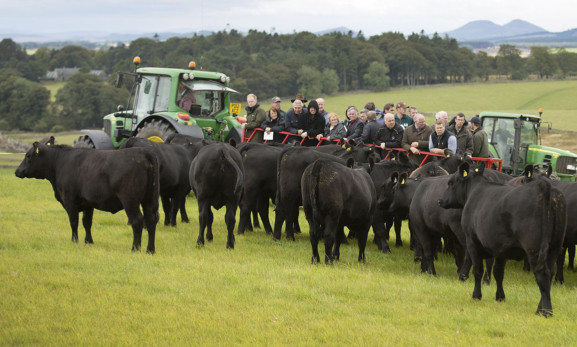Scotland’s pedigree beef cattle breeders must up their game by adopting the latest genetic technology to ensure quality Scotch beef remains competitive in the market place, NFU Scotland president Nigel Miller has warned.
Part of the £45 million fund earmarked by the Scottish Government for beef improvement over the next three years should be used to develop genetic programmes to help commercial beef producers become more efficient, he told more than 1,000 beef farmers attending the centenary open day of the Wedderlie Aberdeen-Angus herd at Gordon, Berwickshire.
Mr Miller praised herd owners John and Marion Tilson and daughter Wanda Hobbs for their use of estimated breeding values (EBVs) to improve the performance of their 200-cow herd, which is one of the top Aberdeen-Angus herds in the country.
“The Wedderlie herd is showing the way by incorporating all available technology into their breeding programme, with an emphasis on maternal EBVs, to produce commercial cattle for the commercial market,” said Mr Miller.
“They have demonstrated how top quality cattle can be produced on grass on a high-lying hill farm presenting many challenges.”
But Mr Miller said Scotland was falling behind Ireland, where EU money was being used to finance an ambitious data capture programme including carcase information and eating quality to help producers in their selection of breeding stock, and also a performance testing programme to assess the commercial progeny of selected sires.
“We have quite a lot to learn from Ireland, where they are proving smarter and are moving forward more quickly than we are in Scotland,” said Mr Miller.
“Capturing all the relevant performance information on one central database would give us an extremely powerful tool.”
The independent testing of commercial progeny would validate performance information and eliminate ‘rogue’ data, while individual feeding would enable feed conversion efficiency to be assessed.
Contrary to popular belief, research in Ireland had indicated bulls showing the highest liveweight gains were not necessarily the most efficient in converting feed into beef.
Reducing feed intake by as much as 7kg per head would trim costs and be a major bonus for the industry.
There was a need to identify the genetics of cattle producing a higher proportion of the best cuts in a carcase, rather than just huge rumps and mince, which could be worth as much as £200 in carcase value.
Research at the Roslin Institute had also indicated that the progeny of some sires had a higher resistance to TB than others, and the same might also apply to Johne’s diseases which offered tremendous potential advantages to beef producers.
SRUC beef expert Dr Basil Lowman warned that the continued emphasis on liveweight gain in all breeds could lead to the breeding of “elephants” in the future.
The Aberdeen-Angus breed had made tremendous progress in increasing average 400-day weights by 20kg over the past 10 years, but there were indications that this trend was having an adverse effect on calving ease.
“The aim must be to get cattle to grow as fast as possible up to 400 days and then stop,” he said.
“It is now almost impossible to sell bulls with poor calving figures.
“The breed is going in the wrong direction and should be looking to select females with a big pelvis for easy calving rather than concentrating on a further increase in growth rates,” Dr Lowman added.
The Wedderlie herd was again showing the way and had increased growth rates above the breed average while improving calving ease and increasing 200-day milk weight at double the breed average by concentrating on maternal EBVs in the selection of females for breeding.
